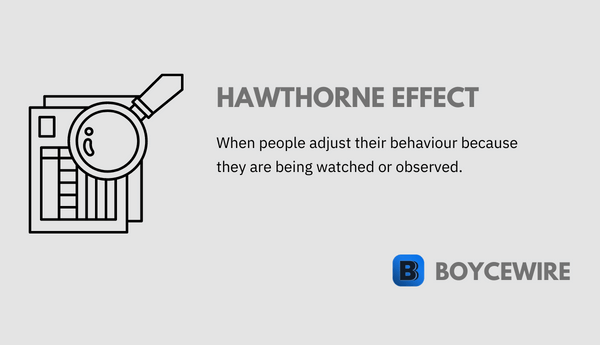Hawthorne Effect: Definition, Study & Example

What is the Hawthorne Effect
The Hawthorne Effect occurs when individuals adjust their behaviour as a result of being watched or observed. For example, employees may work harder and more diligently knowing their manager is closely watching, or children behave better because their parents are looking on.
The Hawthrone Effect originates from an experiment conducted between 1924 and 1932 in the Hawthorne Works electrical plant in Illinois, USA. In the study, the researchers changed the lighting conditions in the factory to see what effect it had on employee performance. It concluded that there was an increase in productivity no matter the lighting – even when workers were in candlelight. However, once the experiment was concluded, workers’ productivity fell back down again.
Other experiments were also conducted with other variables including changes in working hours and breaks. Yet they all saw the same conclusion – an increase in productivity during the experiment, and a decline after. This led to the conclusion that productivity was only increasing because the workers were being watched. This phenomenon would later be known as ‘the Hawthorne Effect’.
Key Points
- The Hawthorne Effect is where an employee’s productivity increases in response to being actively monitored.
- The Hawthorne Effect study concludes that the effect of someone monitoring the employee is the main contributory factor instead of other variables.
- One example of the Hawthorne Effect can be seen in psychology. Often patients can hold back on their emotions whilst being watched or questioned. However, once asked to write down their feelings, patients often open up.
The actual term ‘the Hawthorne Effect’ was first coined by Henry A. Landsberger in 1958, after studying the research done at the Hawthorne Works electrical plant. Landsberger defined the Hawthorne Effect as a short-term impact on a worker’s productivity as a result of the researching watching them. After highlighting that productivity only dropped off once the workers were no longer being observed – it was concluded that this contributed to ‘the Hawthorne Effect’ and the increase in productivity.
Hawthorne Effect Study
Between the years of 1924 and 1932, there were a number of experiments conducted at the Hawthorne Works electrical plant in Illinois. The first and most famous is that of lighting changes. The aim was to determine how much of an impact lighting has on the productivity of the worker. Higher levels of lighting would cost the company more, so if there was an increase in productivity, it would be worth the cost.
The company already had a record of its productivity rates before the experiment begun. This gave it a basis to work from and compare the different levels of productivity using multiple variables. At the time, the Hawthorne Effect was not a variable that the researchers considered. As far as they were concerned, the only changing variable was the lighting.
After the study, there was no real difference between high levels of lighting and low levels of lighting. However, there was a boost in productivity once the experiment started, which fell off once it concluded.
There were other studies that included changes in the number and length of breaks and the length of the working day. However, the illumination study is most prominently used by industrial/psychological and occupational textbooks.
Hawthorne Effect Examples
Example #1 – Teaching
In teaching, it is common to see the Hawthorne Effect in action. For example, the teacher may know that the headteacher or principle is observing them, so make the extra effort on their lesson plan and performance. At the same time, the presence of the principle can have an effect on children’s behavior. Knowing they are watching may provide an incentive for the children to behave in fear that they may face disciplinary action.
Example #2 – Interviews
As a candidate going for an interview, we always want to show the best side of ourselves. The one that is professional, friendly, and hard-working – not the one that procrastinates and is always late. The very pressure of being observed under the microscope makes us change our behaviour in order to obtain a favourable perception. This may make some extremely nervous due to the pressure, whilst others may thrive under the circumstances.
Example #3 – Healthcare
In 2015, the infection prevention department at Santa Clara Valley Medical Center in San Jose, California, conducted thousands of observations on its medical staff. When the staff knew they were being observed, hand hygiene recommendations were adhered to more stringently. The staff knew the recommendations but chose to follow them only when they knew they were being watched. This meant that hygiene standards were not being adhered to during normal working conditions. In turn, this signals that workers tend to cut corners when they can if they know they can get away with it.
Example #4 – Psychology
In the medical profession of psychology, psychologists will ask a number of personal questions. Understandably, these answers and the patient’s behaviour may change as a result of being in the spotlight. Asking about bereavement and such can be emotional, so people will tend to hide their feelings. Yet this behaviour can change when patients are asked to write their thoughts down on a paper – whilst the therapist is absent.
Example #5 – Sports
We all know of cases where we see the next upcoming start in a sport. They look like the next superstar in the minor leagues but fail to cut it in the mainstream. Having thousands of fans in the stadium, cheering and demanding perfection can prove too much for some. The effect of having
How to Avoid the Hawthorne Effect
Avoiding the Hawthorne effect will depend on a number of factors, including what environment it is in. For instance, workers can be examined and tracked using technological solutions such as hidden screen sharers – so you know if a worker is just scrolling through Facebook. Or, in a factory, there may be small, hidden cameras.
In the case of psychology, it may be best for the patient to write down their thoughts rather than potentially be influenced by the therapist’s presence. Alternatively, the Hawthorne Effect may create a positive response – by which it is desired and therefore shouldn’t be ignored.
You then have the case of sports stars. The best players of any sport are those who do not let the Hawthorne effect impact on them. Thousands of people watch them live, week in, week out. Yet they perform as if nobody is there. The secret lies in practice and experience. They become so used to the presence of individuals that they perform as if they were not even there.
FAQs
Example #1 – Teaching
In teaching, it is common to see the Hawthorne Effect in action. For instance, the teacher may know that they are being observed by the principal or headteacher, so make the extra effort on their lesson plan and performance. At the same time, the presence of the principle can have an effect on children’s behavior. Knowing they are watching may provide an incentive for the children to behave in fear that they may be told off.
The Hawthorne effect occurs when individuals change their behaviour in reaction to being observed or watched.
The Hawthorne effect originates from a serious of experiments conducted in the Hawthorne Works electrical plant in Illinois, USA. In the experiments, it was found that the productivity of its workers increased when they were being watched, and declined when they were not.
About Paul
Paul Boyce is an economics editor with over 10 years experience in the industry. Currently working as a consultant within the financial services sector, Paul is the CEO and chief editor of BoyceWire. He has written publications for FEE, the Mises Institute, and many others.

Further Reading
 Human Development Index - The Human Development Index (HDI) is a composite measure that assesses a country's overall development based on indicators such as…
Human Development Index - The Human Development Index (HDI) is a composite measure that assesses a country's overall development based on indicators such as…  Causes of the Great Depression - The Great Depression was caused by a combination of factors including the stock market crash of 1929, overproduction and overinvestment,…
Causes of the Great Depression - The Great Depression was caused by a combination of factors including the stock market crash of 1929, overproduction and overinvestment,…  Equity Research - Equity research involves analyzing and evaluating publicly traded companies to provide investment insights and recommendations to investors.
Equity Research - Equity research involves analyzing and evaluating publicly traded companies to provide investment insights and recommendations to investors. 